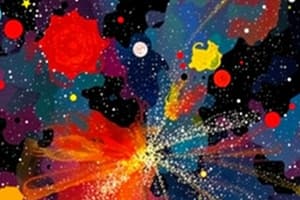Podcast
Questions and Answers
What determines what a star will be like?
What determines what a star will be like?
A star's mass
Where are all stars born?
Where are all stars born?
Nebula
What pulls all matter together to form a star?
What pulls all matter together to form a star?
Gravity
What is needed for nuclear fusion to happen?
What is needed for nuclear fusion to happen?
Where does nuclear fusion have to take place in a star?
Where does nuclear fusion have to take place in a star?
What are red stars characterized by?
What are red stars characterized by?
What defines an orange star?
What defines an orange star?
How is a yellow star characterized?
How is a yellow star characterized?
What are the characteristics of a white star?
What are the characteristics of a white star?
Describe a blue giant star.
Describe a blue giant star.
What brightness level do low mass stars typically have?
What brightness level do low mass stars typically have?
What temperature are low mass stars usually?
What temperature are low mass stars usually?
What colors can low mass stars be?
What colors can low mass stars be?
What is the life span of low mass stars?
What is the life span of low mass stars?
What is the size of low mass stars?
What is the size of low mass stars?
What is the brightness level of high mass stars?
What is the brightness level of high mass stars?
What temperature do high mass stars have?
What temperature do high mass stars have?
What colors can high mass stars be?
What colors can high mass stars be?
What is the size characteristic of high mass stars?
What is the size characteristic of high mass stars?
What is the lifespan of high mass stars?
What is the lifespan of high mass stars?
What are the classifications used for stars?
What are the classifications used for stars?
Describe small stars.
Describe small stars.
What defines medium stars?
What defines medium stars?
What are the traits of large stars?
What are the traits of large stars?
What are bigger stars characterized by?
What are bigger stars characterized by?
Where are the largest stars typically located?
Where are the largest stars typically located?
Where are the coolest and dimmest stars found?
Where are the coolest and dimmest stars found?
Where are the coolest and brightest stars located?
Where are the coolest and brightest stars located?
Where are the hottest and dimmest stars found?
Where are the hottest and dimmest stars found?
Where are the hottest and brightest stars located?
Where are the hottest and brightest stars located?
What does color tell us about stars?
What does color tell us about stars?
How does size relate to luminosity in stars?
How does size relate to luminosity in stars?
Flashcards are hidden until you start studying
Study Notes
Star Classification Basics
- A star's mass significantly determines its characteristics, including brightness and life cycle.
- All stars originate in a nebula, a vast cloud composed of dust and gases.
- Gravity is the force responsible for gathering matter to form a star.
Star Formation Process
- Heat and pressure are crucial for nuclear fusion, which occurs in the star's core.
- Nuclear fusion is the process that powers stars, converting hydrogen into helium.
Types of Stars
- Red Stars: Have low mass and are characterized by low temperature and brightness.
- Orange Stars: Possess slightly more mass and are marginally hotter, bigger, and brighter than red stars.
- Yellow Stars: Exhibit medium characteristics in terms of size, brightness, and temperature; the Sun is a yellow star.
- White Stars: Have a large mass, are very hot and bright.
- Blue Giant Stars: Represent the largest, hottest, brightest stars in the universe.
Low Mass Stars
- Typically dim and cool, featuring colors like red, yellow, and orange.
- Possess a lengthy lifespan that can span billions of years.
- Generally smaller in size compared to high mass stars.
High Mass Stars
- Known for being very bright and hot, often appearing white or blue.
- Are larger in size, but have a short lifespan compared to low mass stars.
Criteria for Classifying Stars
- Stars are classified based on multiple criteria:
- Brightness
- Magnitude
- Size
- Color
- Temperature
- Mass
Star Size Categories
- Small Stars: Can be hot with long lifespans, with varying brightness.
- Medium Stars: Exhibit half brightness and are mid-way through their life cycles, found in the main sequence phase.
- Large Stars: Near the end of their life, generally cooler than smaller stars and predominantly gaseous.
- Bigger Stars: Less luminous due to lower heat and light production from nuclear fusion.
- Largest Stars: Positioned in the upper right of the Hertzsprung-Russell diagram, indicating higher temperature and density.
Hertzsprung-Russell Diagram Insights
- The coolest and dimmest stars are located in the lower right corner.
- The coolest but brightest stars can also be found in the lower right corner, under specific conditions.
- Hottest and dimmest stars reside in the lower left corner of the diagram.
- Conversely, hottest and brightest stars are located in the upper left corner.
Importance of Star Color
- A star's color reveals its temperature: blue stars are hot, while red stars indicate warmth.
Relation Between Size and Luminosity
- Size impacts luminosity; larger stars emit more light and heat, correlating with brightness.
Studying That Suits You
Use AI to generate personalized quizzes and flashcards to suit your learning preferences.




